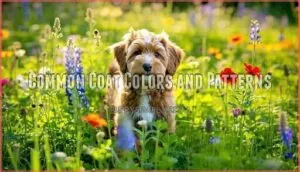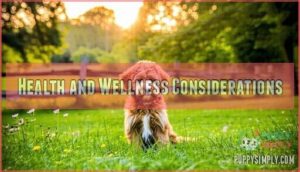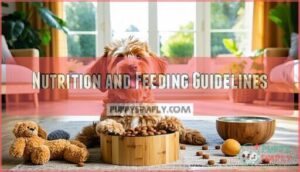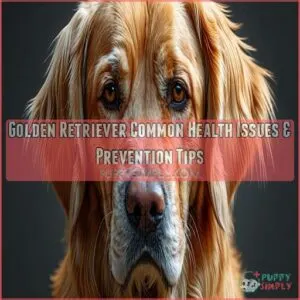This site is supported by our readers. We may earn a commission, at no cost to you, if you purchase through links.
 When my friend Sarah told me her "miniature" Goldendoodle had grown to nearly 40 pounds, she laughed and said, "I guess mini means something different in doodle world." She’s not alone—thousands of prospective owners fall in love with the promise of a compact companion, only to discover that a full-grown mini Goldendoodle can vary wildly in size depending on genetics, generation, and breeding lines.
When my friend Sarah told me her "miniature" Goldendoodle had grown to nearly 40 pounds, she laughed and said, "I guess mini means something different in doodle world." She’s not alone—thousands of prospective owners fall in love with the promise of a compact companion, only to discover that a full-grown mini Goldendoodle can vary wildly in size depending on genetics, generation, and breeding lines.
These teddy bear hybrids pack Golden Retriever warmth and Poodle smarts into a more manageable frame, but "manageable" might mean anywhere from 15 to 35 pounds once they hit adulthood.
Understanding what you’re really getting—from their plateau weight at 12-18 months to their grooming demands and exercise needs—makes all the difference between delightful surprise and buyer’s remorse.
Table Of Contents
- Key Takeaways
- What is a Full Grown Mini Goldendoodle?
- How Big Do Mini Goldendoodles Get?
- Factors Influencing Mini Goldendoodle Size
- Appearance of Full Grown Mini Goldendoodles
- Temperament and Personality Traits
- Grooming Needs and Coat Care
- Health and Wellness Considerations
- Nutrition and Feeding Guidelines
- Exercise and Activity Requirements
- Life With a Full Grown Mini Goldendoodle
- Frequently Asked Questions (FAQs)
- How big is a full grown mini Goldendoodle?
- What are the disadvantages of a mini Goldendoodle?
- Do mini Goldendoodles bark a lot?
- What do I wish I knew before getting a Goldendoodle?
- How big is a mini Goldendoodle full grown?
- Are mini Goldendoodles good dogs?
- What does a full size mini doodle look like?
- Do mini Goldendoodles adapt well to travel?
- What is the ideal diet for Mini Goldendoodles?
- How do Mini Goldendoodles handle being alone?
- Conclusion
Key Takeaways
- Mini Goldendoodles hit their full adult size between 11-18 months and typically weigh 15-35 pounds at 13-20 inches tall, though "mini" can mean anything from a 10-pound teacup to a 45-pound small standard depending on breeding lines and generation mix.
- Their grooming demands are substantial—expect daily brushing for curly coats, professional haircuts every 6-12 weeks, and significant coat changes between 6-12 months when puppy fluff transitions to adult texture, making maintenance a serious time and financial commitment.
- These dogs combine Golden Retriever warmth with Poodle intelligence to create emotionally sensitive companions who don’t handle alone time well, need 30-60 minutes of daily exercise, and thrive on mental stimulation through puzzle games and training rather than just physical activity.
- Health concerns include hip dysplasia, patellar luxation, progressive retinal atrophy, and various metabolic issues, making regular vet visits, preventative care, and choosing a responsible breeder who does genetic testing absolutely critical for long-term wellness.
What is a Full Grown Mini Goldendoodle?
So what exactly are you getting when a Mini Goldendoodle hits full size? These adorable designer dogs bring together the best of Golden Retrievers and Poodles, but "full grown" means something specific—and it’s worth understanding before you commit.
Let’s break down what this crossbreed really is and when they officially stop growing.
Mini Goldendoodle Breed Overview
If you’ve ever wondered what happens when you mix the gentle soul of a Golden Retriever with the whip-smart, low-shedding coat of a Poodle, you’re looking at the Mini Goldendoodle—a crossbreed that’s stolen hearts across dog-loving households everywhere. This designer breed brings together the best genetic traits from both parents: the Goldendoodle’s friendly, people-loving nature and the Poodle’s intelligence and hypoallergenic coat.
What started as intentional breeding for therapy and service work has evolved into one of the most sought-after family dogs around. Thanks to hybrid vigor, these pups often enjoy better health than their purebred cousins.
Whether you’re drawn to their adaptability or their eager-to-please personality, understanding the Mini Goldendoodle breed overview helps you appreciate what makes them special.
Defining “Full Grown” in Dogs
When people say a dog is “full grown,” they’re really talking about that ideal point where your pup has hit their adult size and their body has stopped doing all that rapid, unpredictable growing. For Mini Goldendoodles, reaching full grown status usually happens somewhere between 1 to 2 years old—though breed maturity isn’t just about the number on the scale.
Here’s what defines that key point:
- Physical Growth Patterns: Bones have finished lengthening, and your dog’s frame has filled out completely
- Development Phases: Puppy energy shifts into a more settled, predictable temperament
- Size Standards: Weight and height stabilize according to their specific Goldendoodle size category
- Maturity Stages: They’ve transitioned from awkward adolescence into confident adulthood
Understanding dog growth helps you track whether your Mini Goldendoodle is developing on schedule.
How Big Do Mini Goldendoodles Get?
One of the first things people want to know is just how big their Mini Goldendoodle will actually get. The answer isn’t quite as simple as a single number—there’s a surprising range depending on breeding, genetics, and even how you raise them.
Let’s break down what to expect regarding weight, height, and when your pup will finally reach their full size.
Average Adult Weight and Height
Most adult Mini Goldendoodles settle between 15 to 35 pounds, with the ideal range around 25 to 35 pounds. Height ranges usually land between 13 to 20 inches at the shoulder—most hit that 15 to 17-inch mark. Size genetics from the parent Poodle influences adult proportions markedly. Growth patterns show your pup reaching about half their full-grown size by four to five months. Understanding the factors of size growth stages is vital for anticipating and preparing for your Mini Goldendoodle’s development.
| Age | Weight Range | Height Range |
|---|---|---|
| 6 months | 10–22 lbs | 10–15 inches |
| 12 months | 20–32 lbs | 13–18 inches |
| 18 months | 25–35 lbs | 15–20 inches |
Males tend to be 2 to 5 pounds heavier than females.
Size Variations (Teacup, Toy, Standard)
Mini Goldendoodles aren’t a one-size-fits-all breed—they come in several categories that dramatically affect weight factors and miniature traits. Teacup Mini Goldendoodles weigh just 10 to 13 pounds and stand 9 to 12 inches tall, making them the tiniest option. Toy versions range from 10 to 20 pounds with heights of 13 to 15 inches. True Miniature Goldendoodles hit 15 to 30 pounds and 13 to 20 inches. Small Standard dogs push 30 to 45 pounds at 17 to 20 inches, while Large Standard Goldendoodles reach 45 to 90 pounds.
Understanding these breed standards helps you choose the right fit for your lifestyle and space. When considering a Mini Goldendoodle, it’s vital to research mini dogs to make an informed decision.
Growth Timeline and Milestones
Your Mini Goldendoodle’s journey from tiny newborn to full-sized adult follows a surprisingly predictable pattern—and knowing these key milestones helps you prepare for each stage. At birth, puppies weigh just 1 pound.
By 4-5 months, they hit half their adult weight—around 7-15 pounds depending on size category. Most Mini Goldendoodles reach full size between 11-13 months, though some keep filling out until 18-24 months.
Using a growth chart helps track puppy development and make accurate size predictions throughout these growth stages.
Factors Influencing Mini Goldendoodle Size
Your Mini Goldendoodle’s final size isn’t set in stone—it’s shaped by a mix of factors you can partly control. From the parents they inherit genes from to the food in their bowl and the exercise they get each day, these elements work together to determine how big your pup will actually grow.
Let’s break down the three main influences that’ll shape your dog’s adult size.
Genetics and Breeding Lines
Regarding adult size, breeding choices matter more than you might think. The generation—whether F1, F1b, or multigen mini goldendoodle—shapes everything from weight to coat variation through inheritance patterns. Genetic testing and breeding strategies help responsible breeders exploit hybrid vigor while predicting outcomes with near-genetic guarantee accuracy.
Three key breeding factors that influence size:
- F1 Irish mini goldendoodle crosses blend 50-50 genetics, creating moderate size ranges with strong hybrid vigor
- F1b mini goldendoodle backcrosses favor smaller Poodle ancestry, often yielding petite, consistent builds
- Multigen programs use dog breeding and genetics protocols to fine-tune size predictability across generations
Nutrition and Feeding Habits
What you feed your mini goldendoodle—and how much—directly shapes whether they land on the smaller or larger end of their genetic potential. Overfeeding during puppyhood can push growth beyond natural limits, while balanced meal portions keep development steady. Quality dog food with proper nutrient balance prevents deficiencies that stunt growth, and addressing food allergies early protects their digestive health, ensuring they thrive within their breed range.
| Feeding Factor | Impact on Size |
|---|---|
| Puppy Food Quality | High-protein formulas support healthy bone and muscle development |
| Meal Frequency | 2-3 meals daily prevent overeating and maintain steady growth |
| Calorie Control | Excess calories increase adult weight; balanced portions refine size |
Exercise and Lifestyle Impact
Picture your mini goldendoodle cooped up inside all day—without the chance to burn off that legendary doodle energy, they’re not just getting restless, they’re potentially outgrowing their ideal weight range. Daily walks, outdoor adventures, and play therapy keep muscles lean and prevent excess weight gain.
Mental stimulation through social interactions bolsters overall dog health, proving that lifestyle and pet compatibility directly influence dog size. Active exercise routines don’t just tire them out—they sculpt their adult build.
Appearance of Full Grown Mini Goldendoodles
One look at a full grown Mini Goldendoodle and you’ll see why they turn heads everywhere they go. Their appearance combines the best of both parent breeds, creating a look that’s equal parts adorable and distinctive.
Let’s break down what you can expect regarding their coat colors, textures, and how that fluffy puppy transforms into a stunning adult dog.
Common Coat Colors and Patterns
One look at a full-grown Mini Goldendoodle and you’ll see why their coat is such a showstopper—these pups come dressed in everything from creamy champagne and apricot to rich chocolate, solid black, or even a striking red that catches everyone’s eye. Coat color genetics can surprise you, though:
- Fading colors are common as your dog matures
- Pattern variations include parti, phantom, and abstract markings
- Ticking effects create freckled or speckled looks
- Mini Goldendoodle appearance shifts subtly over time
- Nonshedding coat characteristics influence color intensity
That’s why your pup’s shade might evolve beautifully through adulthood.
Coat Types (Straight, Wavy, Curly)
Your Mini Goldendoodle’s coat texture is like a personality trait—it can swing anywhere from sleek and straight (hello, Golden Retriever genes) to tightly spiraled ringlets (thanks, Poodle side), with most landing somewhere in that perfect wavy middle ground. Coat genetics play a huge role here, and each type brings its own grooming differences and curl maintenance needs.
| Coat Type | Shedding Amount | Grooming Needs |
|---|---|---|
| Straight coat | Light to moderate | Brush every 2-3 days |
| Wavy coat | Minimal | Daily to every other day |
| Curly coat | Very minimal (most hypoallergenic) | Daily brushing essential |
| Mixed textures | Varies by section | Adapt to curliest areas |
| Puppy fluff | Changes markedly | Gentle, frequent brushing |
Wavy and curly coats are your best bet for hypoallergenic qualities, while straight-coated Mini Goldendoodles may shed a bit more but require less intensive grooming overall.
Changes From Puppy to Adult Coat
That fluffy puppy coat you fell in love with? It’s not sticking around forever—somewhere between 6 and 12 months, your Mini Goldendoodle will start trading in that soft baby fur for their true adult coat, and the transformation can be pretty dramatic.
Colors often deepen or lighten, fur texture shifts from wispy to wavy or curly, and shedding patterns change completely. This coat shift hits hardest around 8-10 months—expect mats and tangles galore if you’re not brushing daily during this phase.
Temperament and Personality Traits
Once you see that fluffy face every day, you’ll understand why Mini Goldendoodles have stolen so many hearts.
Their personality is just as appealing as their looks, blending the best traits from both parent breeds into one lovable package.
Let’s look at what makes their temperament so special and why they fit into so many different families.
Social and Family-Friendly Nature
If there’s one thing that makes a Mini Goldendoodle truly shine, it’s their natural gift for fitting seamlessly into the heart of a family. These loyal friends form deep emotional bonds with everyone—kids, adults, even other pets.
Their playful nature and social skills make them exceptional pet companions, whether you’re looking for emotional support or just a furry buddy who genuinely loves being around people. Dog ownership doesn’t get much sweeter than this.
Intelligence and Trainability
Beyond their loving nature, Mini Goldendoodles also happen to be whip-smart—and that combination of brains and eagerness to please makes training feel less like work and more like bonding time.
Their cognitive development and problem-solving skills shine during obedience training, where they pick up commands quickly. You’ll find their trainability makes behavioral modification straightforward—they genuinely want to learn.
Canine training becomes a joyful partnership when your mini goldendoodle’s intelligence meets your consistent learning strategies.
Emotional Sensitivity and Bonding
What makes these dogs truly special, though, is how they tune into your emotions like a living, breathing mood ring—they feel what you feel, and that creates a bond that goes deeper than most people expect. This canine empathy strengthens social bonds and owner attachment naturally.
Many dog owner testimonials highlight how their mini goldendoodle provides emotional support during tough times. That sensitivity training pays off—your canine companion experiences life alongside you, making pet ownership and responsibility feel more like partnership than duty.
Mini Goldendoodles bond deeply with their owners, offering emotional support that transforms pet ownership into genuine partnership
Grooming Needs and Coat Care
Your Mini Goldendoodle’s coat is one of their most charming features, but it won’t take care of itself. Regular grooming keeps them comfortable, healthy, and looking their best. Here’s what you need to know about brushing routines, haircuts, and adjusting your care throughout the year.
Brushing and Shedding Expectations
Here’s the deal: a Mini Goldendoodle’s coat won’t shed all over your couch like a Golden Retriever, but don’t think that means you’re off the hook with the brush. Curly coats need daily brushing to prevent mats, while wavy ones can go every other day.
Invest in quality grooming tools—a slicker brush and metal comb work wonders for coat maintenance and shedding control. Skip a few days, and you’ll be wrestling tangles.
Haircut Frequency and Styles
Every six to twelve weeks, your Mini Goldendoodle’s going to need a proper haircut to keep that coat looking fresh and feeling comfortable. Professional dog grooming works best for most owners—groomers know clipper techniques and facial haircuts that keep eyes clear and paws tidy. Popular coat styling options range from puppy trims (shorter, easier maintenance) to teddy bear cuts.
Between visits, keep grooming tools handy for touch-ups as your dog’s coat changes with age.
Seasonal Grooming Considerations
Your Mini Goldendoodle’s grooming needs shift with the seasons—winter coats thicken for warmth while summer heat calls for lighter trims. Here’s how to adapt your dog grooming tips year-round:
- Winter Coat Care protects against cold but requires frequent brushing to prevent autumn matting underneath.
- Spring Trimming reduces summer shedding and keeps your Mini Goldendoodle comfortable as temperatures rise.
- Holiday Grooming before family gatherings ensures your pup looks photo-ready with professional dog grooming touch-ups.
Health and Wellness Considerations
Your Mini Goldendoodle’s health deserves the same attention you give to their grooming and training. Like any breed, these lovable pups can face specific health challenges that you’ll want to stay ahead of.
Let’s walk through what you need to know to keep your full-grown companion happy and thriving for years to come.
Common Health Issues
Like any dog breed, canine health matters deserve your attention with Mini Goldendoodles. Orthopedic problems like hip dysplasia and patellar luxation top the list—hip dysplasia accounts for over half of developmental orthopedic issues.
Eye disorders such as Progressive Retinal Atrophy can steal vision gradually. Metabolic issues including hypothyroidism and Addison’s disease affect energy and weight.
Allergic reactions cause itching and ear infections, while cardiac diseases like subvalvular aortic stenosis pose serious risks requiring veterinary care.
Regular Veterinary Care
Think of vet visits as your Mini Goldendoodle’s insurance policy—routine check-ups catch problems before they snowball into expensive emergencies. Your vet manages vaccine schedules, health checks, and parasite control during annual appointments.
Don’t skip dental care—gum disease affects overall canine health.
Keep emergency prep contacts handy, and schedule veterinary care every six to twelve months for peak dog health and wellness.
Preventative Health Measures
Skipping preventative care is like ignoring a check engine light—you’ll pay the price later when something small turns catastrophic. Stay ahead with vaccine schedules, annual health screenings, and parasite control. Consider dietary supplements if your vet recommends them for joint or skin health.
Keep emergency preparedness contacts saved and practice basic dog health routines daily. Smart pet care and behavior habits now mean fewer veterinary visits down the road—your Mini Goldendoodle care approach should always be proactive, not reactive.
Nutrition and Feeding Guidelines
Feeding your full grown Mini Goldendoodle the right way isn’t complicated, but it makes all the difference in their energy, coat health, and overall happiness. Getting the portions right, knowing when to switch foods, and keeping them hydrated are the building blocks of good nutrition.
Let’s break down what your adult Mini Goldendoodle needs to thrive.
Adult Feeding Amounts and Frequency
Once full grown, most Mini Goldendoodles thrive on two balanced meals daily—morning and evening, spaced 8 to 12 hours apart. Feeding schedules stay steady through adulthood.
Meal portions depend on weight: dogs around 25 pounds usually need 1½ to 2½ cups of high-quality food daily, totaling 400 to 600 calories. Active pups might need slightly more to fuel their energy.
Monitor caloric needs, nutrient balance, and digestive health by checking their waistline monthly and adjusting portions as needed.
Transition From Puppy to Adult Food
Switching your Mini Goldendoodle’s food should happen gradually around 6 to 9 months old, when their puppy phase winds down and their adult appetite kicks in.
Mix 25% adult diets into puppy food for the first few days, then increase to 50%, 75%, and finally 100% over 7 to 10 days.
This slow food shift protects your Goldendoodle puppies’ digestion, preserves nutrient balance, and prevents upset stomachs while their dog nutrition needs evolve.
Hydration and Special Dietary Needs
Once you’ve got the food shift down, water becomes your next daily non-negotiable—your Mini Goldendoodle needs about an ounce of fresh water for every pound they weigh. Keep that bowl filled and clean to support digestive health and nutrient balance.
Watch for food allergies like itchy skin or stomach issues, and talk to your vet about dietary supplements if your pup needs extra joint or coat support for ideal dog health and wellness.
Exercise and Activity Requirements
Your full grown Mini Goldendoodle has energy to spare, and staying active keeps them healthy and happy. These dogs aren’t couch potatoes—they need regular movement and mental challenges to thrive.
Here’s what you need to know about keeping your pup entertained and exercised.
Daily Exercise Needs
A full-grown Mini Goldendoodle needs about 30 to 60 minutes of exercise each day to stay happy, healthy, and out of trouble. This doesn’t mean marathon runs—think daily walks around the neighborhood, outdoor play sessions in the yard, or a good game of fetch.
Dog owners who skip regular physical activity often notice unwanted dog behavior like excessive barking or chewing. Exercise routines keep your pup mentally balanced and physically fit, which is essential for proper dog care.
Playtime and Mental Stimulation
Beyond those daily walks, your Mini Goldendoodle craves brain games and interactive play that challenge their sharp mind just as much as their body. These playful exercises keep dog behavior balanced and prevent boredom-driven mischief.
Try these brain stimulation ideas:
- Puzzle feeders and interactive toys that reward problem-solving
- Hide-and-seek games with treats or favorite toys
- Social play dates with other dogs for mental and physical engagement
- Short dog training sessions teaching new tricks or commands
Mental games tire them out faster than physical activity alone.
Suitable Activities for Mini Goldendoodles
From backyard fetch marathons to splashing around in dog-friendly lakes, these adaptable pups thrive on activities that blend physical movement with social connection. Dog owners find Mini Goldendoodles excel at agility courses, hiking trails, and family activities like camping trips.
Training exercises during outdoor adventures keep them engaged. Try local dog parks for social events where your pup builds confidence with other pets.
These playtime ideas transform routine pet care into memorable bonding experiences your Mini Goldendoodle will absolutely love.
Life With a Full Grown Mini Goldendoodle
Bringing a full grown Mini Goldendoodle into your world means more than just owning a dog—it’s about welcoming a loyal companion who fits into your lifestyle and thrives on connection. Whether you’re in a cozy apartment or a house with a yard, these adaptable pups fit right in with the right approach.
Here’s what life really looks like with a full grown Mini Goldendoodle by your side.
Adaptability to Different Living Environments
Whether you’re in a cozy downtown apartment or a sprawling suburban home, your Mini Goldendoodle will fit right in—these pups are masters at making anywhere feel like their territory.
Urban living suits them fine as long as they get daily walks and playtime. They don’t need acres to thrive, but they do appreciate a yard for zooming around.
What matters most? Your presence and lifestyle compatibility, not square footage.
Training and Socialization Tips
Your Mini Goldendoodle’s intelligence is a gift—but without proper training and socialization, that sharp mind can turn everyday life into creative chaos.
Start with basic obedience and puppy socialization early—expose them to different people, pets, and environments. Positive reinforcement and clicker training work wonders with this breed.
They’re keen to please, making housebreaking tips easier to implement. Consistent dog training and behavior work prevents boredom-driven mischief that dog lovers often face with intelligent breeds.
Real Owner Experiences and Testimonials
Nothing beats hearing from people who’ve actually lived through the puppy chaos, teenage antics, and everyday joys of raising a Mini Goldendoodle from fluff ball to full-grown companion. Dog owners consistently share similar pet reviews:
- Family experiences highlight their gentle nature—kids and cats included
- Owner stories confirm breed comparison advantages: less shedding, more snuggling
- Pet adoption stories emphasize training tips: consistency wins every time
Dog lovers agree these companions transform pet care and behavior routines into genuine friendship.
Frequently Asked Questions (FAQs)
How big is a full grown mini Goldendoodle?
Most Mini Goldendoodles tip the scales between 14 and 45 pounds when fully grown—that’s a surprisingly wide range!
Adult height usually reaches 13 to 20 inches at the shoulder, depending on genetics and nutrition.
What are the disadvantages of a mini Goldendoodle?
Like all breeds, these pups come with challenges. High maintenance grooming demands, potential health issues from genetic defects, training difficulties during their hyper puppy phase, ongoing financial burden, and their intense emotional demands require dedicated owners ready for the commitment.
Do mini Goldendoodles bark a lot?
Think of Bella, a chatty mini goldendoodle who greets every squirrel—her barking patterns depend on training and environment.
These dogs aren’t excessive barkers by nature, but without proper canine communication training and socialization, some develop noisy habits. Most bark to alert you or express excitement, making bark reduction techniques essential for pet owners.
What do I wish I knew before getting a Goldendoodle?
I wish I’d known how much puppy proofing matters—these pups eat everything.
Grooming costs add up fast, and their emotional sensitivity means they mirror your mood.
Financial commitment and longevity planning are real.
How big is a mini Goldendoodle full grown?
Full-grown mini Goldendoodles usually weigh 14-45 pounds and stand around 13-20 inches tall at the shoulder.
Size factors include genetics, nutrition, and whether they’re bred from toy or miniature poodles, affecting their adult height and final weight.
Are mini Goldendoodles good dogs?
These canine companions are genuinely wonderful family pets. Their cheerful temperament, dog friendliness, and pet loyalty make them incredibly popular.
Goldendoodle characteristics include trainability, emotional sensitivity, and getting along great with kids and other pets—making pet ownership a joy.
What does a full size mini doodle look like?
Picture a teddy bear come to life—that’s your mini doodle at full size. They usually stand 13-20 inches tall, weighing anywhere from 14-45 pounds.
Coat colors range from cream and apricot to red and chocolate, with textures varying from loose waves to tight curls that frame their sweet, expressive faces.
Do mini Goldendoodles adapt well to travel?
These pups are surprisingly excellent travelers—they’re compact, calm when trained properly, and love being with you. With the right Dog Travel Gear and preparation, road trips become a breeze.
What is the ideal diet for Mini Goldendoodles?
A high-quality dog food rich in protein, healthy fats, and balanced nutrients works best for Mini Goldendoodles.
Feed them 2-3 meals daily—about 5 cups total—adjusting calorie intake based on activity level and weight.
How do Mini Goldendoodles handle being alone?
These people-oriented pups don’t do well with long stretches of social isolation. Mini Goldendoodles can develop separation anxiety if left alone too often, showing signs of dog loneliness through destructive behavior or excessive barking.
Their dog temperament craves companionship, making proper pet training and behavior work essential for managing alone time and preventing abandonment issues.
Conclusion
They grow bigger than you expect, shed less than you hope, and love harder than you imagined—that’s the truth about a full-grown mini Goldendoodle. Size might surprise you, but their heart won’t.
You’ll invest time in grooming, energy in exercise, and patience in training, but you’ll gain a companion who adjusts to your moods, fits into your lifestyle, and fills your home with warmth.
Choose your breeder wisely, commit to consistent care, and you’ll discover why these doodles earn their reputation as perfect family favorites.


















Mark
October 29, 2025 at 05:37 AM
This is an incredibly detailed and helpful article! I really liked how you explained the different stages of growth and personality development in Mini Goldendoodles. The section about maintaining a healthy diet and exercise routine stood out — it’s something every owner should pay attention to, especially as their doodle transitions from puppy to adult.
I’ve also been reading more about the miniature Goldendoodle and learned how genetics, coat type, and training consistency all play a big role in shaping their overall temperament. Your focus on responsible ownership, grooming, and realistic expectations really makes this guide stand out from others.
Overall, this article perfectly balances practical advice and genuine insight — a must-read for anyone planning to bring home a Mini Goldendoodle. Thanks for sharing such valuable and thoughtful information! https://theminigoldendoodles.com/